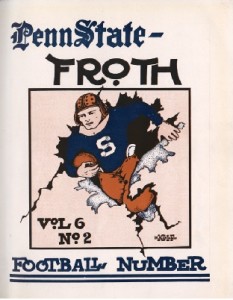 This post was written by Rachel A. McCaskill (née Smith). Rachel was a Diversity Resident Librarian at Penn State, 2013-2015. While at Penn State, Rachel worked with the Special Collections Library and with Digitization and Preservation at the University Libraries on digitizing Penn State Froth magazine issues and getting the collection online. She is now Learning Technologies Librarian at Virginia Commonwealth University Libraries in Richmond, VA.
This post was written by Rachel A. McCaskill (née Smith). Rachel was a Diversity Resident Librarian at Penn State, 2013-2015. While at Penn State, Rachel worked with the Special Collections Library and with Digitization and Preservation at the University Libraries on digitizing Penn State Froth magazine issues and getting the collection online. She is now Learning Technologies Librarian at Virginia Commonwealth University Libraries in Richmond, VA.
The Penn State Froth, the nation’s second oldest college humor magazine, was founded in 1909 and published from 1910 to 1985. It replaced Penn State’s first humor magazine, the Lemon, which published its final issue on June 10, 1908. The Lemon left a major void, as it seems to have been an influential part of student life on campus in the old days. For example, the Lemon covered the birth of Penn State’s Nittany Lion mascot in its publication. A. W. Fisher, editor of the State Collegian, which was a predecessor to The Daily Collegian, served as editor of the first issue of Froth.
During the 1920’s Froth was sold not only on the Penn State campus and in State College, but also in 17 other Pennsylvania towns and cities as well as Washington, D.C., Providence, Rhode Island, and in Syracuse, New York. This popularity led to Froth being named the “Best Managed Humor Magazine” by College Humor Magazine for 1930-31.
Froth eve n had a mascot, a jester named Frothy, who made appearances along with the Nittany Lion at PSU football games. Despite its wide-scale popularity, Froth still was a humor magazine, so there are a LOT of images, graphic design elements, and passages of text that are suggestive and offensive. Froth’s initial run lasted until 1943. It stopped production during World War II due to a lack of staff members, which is a theme found prominently on many of the covers. In 1946 after World War II, Froth resumed printing, but was again stopped in 1962 when the University ruled that the content was too vulgar. In 1965, Froth began printing again, but it lacked the popularity among students and the community, and it saw a decline until an editorial team revived it in 1977. However, as the last members of the 1977 staff graduated in 1981 and 1982, it eventually collapsed. In 1999, the magazine was revamped and the spelling changed from “Froth” to “Phroth”.
n had a mascot, a jester named Frothy, who made appearances along with the Nittany Lion at PSU football games. Despite its wide-scale popularity, Froth still was a humor magazine, so there are a LOT of images, graphic design elements, and passages of text that are suggestive and offensive. Froth’s initial run lasted until 1943. It stopped production during World War II due to a lack of staff members, which is a theme found prominently on many of the covers. In 1946 after World War II, Froth resumed printing, but was again stopped in 1962 when the University ruled that the content was too vulgar. In 1965, Froth began printing again, but it lacked the popularity among students and the community, and it saw a decline until an editorial team revived it in 1977. However, as the last members of the 1977 staff graduated in 1981 and 1982, it eventually collapsed. In 1999, the magazine was revamped and the spelling changed from “Froth” to “Phroth”.
While still fundamentally akin to older styles, satire has evolved over time. Satire is now wittier, in my opinion, and is not intended solely for shock value. Photos of scantily clad women graced many Froth covers after mid-century. In the earlier days, there were suggestive drawings and paintings both on the covers and on the pages in between that reflected overt racism and sexism.
Though the offensive nature of the Froth helped me understand the “why” behind the magazine’s declining popularity over the years, I’m glad to have had the opportunity to help preserve and digitize it so that it can entertain (and offend) readers for years to come!

